A few weeks ago, our kitchen remodel was featured on Design*Sponge as part of their “Before and After” series. We were thrilled to be included and encouraged by the many positive comments. But then, inevitably, came the other comments. The reactions were similar for our kitchen and bathroom posts on Apartment Therapy and in a nutshell, there was a contingent of commenters that were convinced we had obliterated an heirloom.
Truthfully, I wasn’t really offended by the comments (and was somewhat expecting them) – not because I’m necessarily thick-skinned but because I stand by our conviction that what we’ve done has been the right thing for our house. Alongside the positive and negative comments were additional questions about how we should approach the discussion of remodeling in the first place, especially when so much of the blogisphere is dedicated to sparkly end results. It’s something that Kyle and I started discussing and realized the topic might warrant a blog post of its own. We realized that although we have gone through a very careful and intentional remodel thought process, we’ve never really explained it here on the blog.
Don’t get me wrong, we love dramatic “before and afters” just as much as the next person, but we thought it would be interesting to talk about the underlying reasons for taking on a project like this in the first place. So here’s our story.
[Note: each pair of photos was taken from approximately the same view. And no, I didn’t know about white balance back in ’06.]
Plain and simple, we bought a house that needed a lot of work because it’s what we could afford. We were up for the challenge and knew that it was something we both wanted to do. So we bought this:

Ok, she looked a little better (and cuter!) in the 1930’s when this photo was taken. When we took ownership in 2006, she was a bit frumpier:

But over the course of 5 years, she’s got a new spring in her step…
I think we all agree that, yes, our house was ugly. But ugliness alone is not a reason to gut the entire thing. Sure, we could have painted the walls, replaced the carpet and called it a day, but our house had fundamental problems that limited its effectiveness as a 21st-century home.
Layout – As you can see from the original floor plan, our home had an awkward layout that quickly proved to be an inefficient way to live in 770 square feet. (At the root of the problem was the kitchen, which served as the hallway of the house with 5 doorways and very little work space.) By reworking the plan, we were able to create a series of spaces that made more sense for how we live while also accommodating flexibility for future needs. We were also able to add a second bedroom without expanding the footprint. If our home had two bedrooms from the beginning, we probably would have approached things differently.
Because the front door entered into the middle of the dining/living room, the two spaces were the same size, meaning a too small living room and a too big dining room. The chandelier with the faux candles yet real burn marks on the ceiling? No words.

Structure – Our home had not been maintained properly over the years and had some issues that needed more immediate attention. Maybe one reason we didn’t start the blog earlier was because the first few years were not glamorous ones. We completely replaced the roof, undertook a sizeable structural project in the basement and spent an uncomfortable amount of money on asbestos abatement and an oil tank removal. Unglamorous yes, but it was the right thing to do and prevented even bigger (and more expensive) repairs down the road. Does structural safety supersede “preservation”? We think so.
Energy – One of the things that I think is most often overlooked when discussing older homes is that they are usually energy hogs. When we bought our house, it had no insulation in the walls, a ridiculously ancient coal-turned-oil-burning octopus furnace, a 20-year-old hot water heater and leaky aluminum windows. For us, not improving our home’s energy performance would have been irresponsible and well, dumb. In many cases, sustainability drove our decision-making process. For instance, to insulate our exterior walls we could either add it from the outside or the inside. So we weighed the pros and cons and ultimately decided that it was more important to restore our original cedar siding and remove the crumbling plaster on the inside. With the walls opened up, we were also able to add modern-day luxuries like electrical outlets(!) When it came to materials, we made a concerted effort to recycle/sell/salvage as much as we could while also being conscientious about what new materials were coming in.
Education – Although some have surmised that we’re remodeling for remodeling’s sake, just because we’re architects doesn’t mean we think we’re entitled to change something just because we can. I mean really, this stuff is expensive and takes an incredible amount of time and patience. In fact, sometimes…ok, many times, we wish our house had needed less work. But regardless of how we’ve changed our home, the more important thing has been the process of doing so. In fact, before we started looking at houses, we both were toying with the idea of going to grad school, but ultimately decided that we couldn’t afford to do both. So we sometimes joke that the remodel has been our thesis project and in a way, I think we’ve learned far more than we could have in a couple extra studio courses.
Solving the Stylistic Problem – Even though we’re self-proclaimed modernists, we still have an appreciation for the past. Although our house was the one we could afford, we predominantly looked at pre-1930’s homes (which fortunately, Seattle has a lot of). In general, we were attracted to the modest size and simple styles of these homes and knew it would be these characteristics that, due to budget and practicality, would remain unchanged. (I’m sure we drove our realtor crazy…a fixer? No problem! But a complex roof shape? Hell no!) Sadly, even though our home was built in 1910 and was small and simple, it didn’t have any of the charming features that are common to other homes of that era. No built-ins, no fancy molding, no bare wood. Because of this, we felt it was appropriate to take on a more extensive renovation. Where we could, we brought attention to certain original elements – like the exposing the ceiling joists in the living room or restoring the original cedar siding on the exterior.
As architects who are progressive but also concerned about sustainability, there is a great challenge in reinventing existing housing stock to work for the 21st century. It’s a surgical process that is different for every house and includes incorporating the best of both eras into something that will hopefully be around for another one hundred years. (Pretty pictures are nice, but this creative problem solving has really been the crux of our remodel.) For those that think we’ve done our home a disservice, the reality is that had our offer not been accepted, our house would have been victim to the wrecking ball and a 2500 SF “neo craftsman” mcmansion would have been crammed onto the lot in its place.
Anticipating Change – One goal that we’ve tried to maintain throughout this process is not to overdo it. While we’re definitely not looking to flip this house, we also know that we probably won’t live here forever. That means striking the balance between doing the right thing and what makes us happy, while not investing so much money and time that we feel we can never leave. We’re not making any decisions based on “resale value” but we are trying to do something that is thoughtful, creative and appropriate for our neighborhood.
Being Realistic – Our house is at best an experiment. An experiment based on a modest budget, a willingness to live in a constant construction zone and a whole lot of manual labor. It’s not a perfect home, but it is a better home and at the end of the day that’s something we feel really good about.
And there is the “Behind the Scenes” story of chezerbey. Remodeling can be very personal and depends on so many factors that it’s impossible to apply general rules or guidelines to the process. What’s right for one person isn’t necessarily a good solution for another and we hope that the blogisphere can continue to be a forum for constructive dialogue. Crappy old houses all over the world will thank you for it.
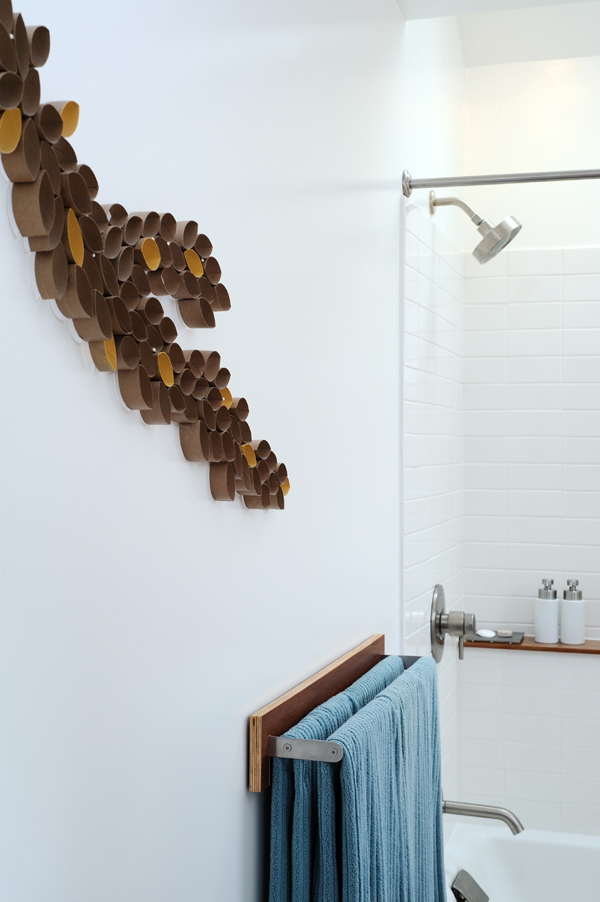

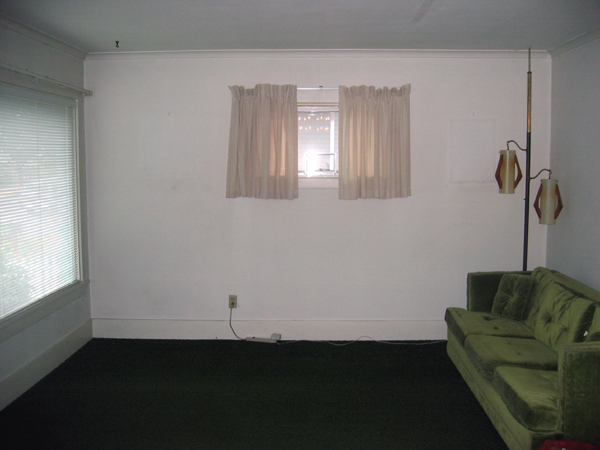


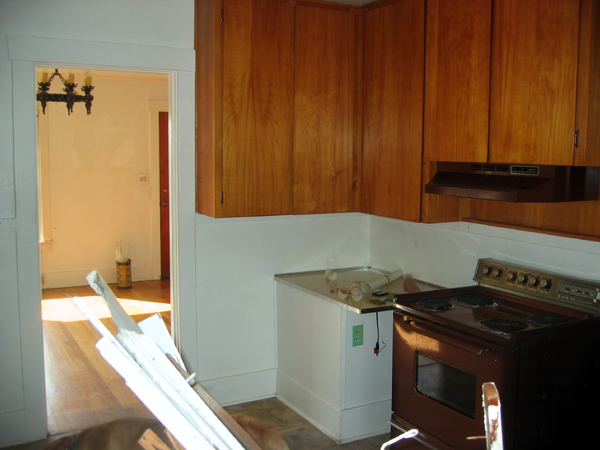

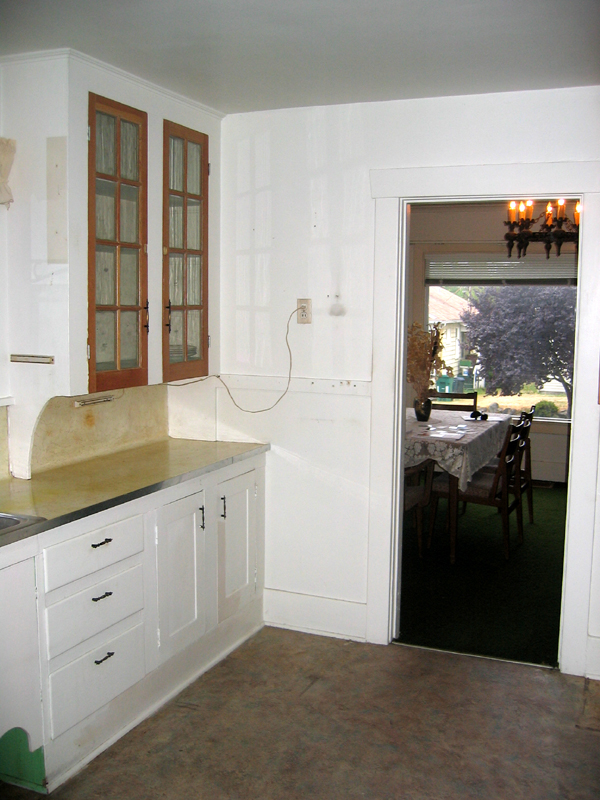
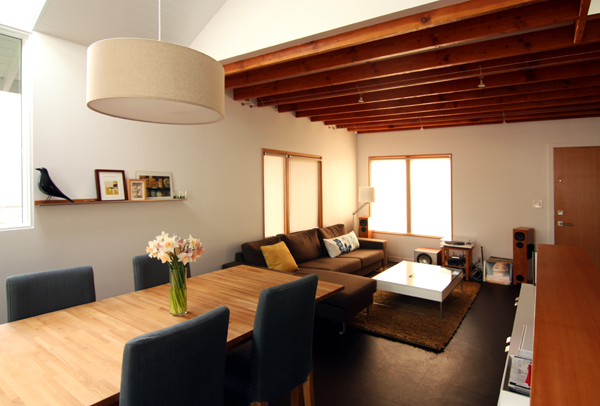
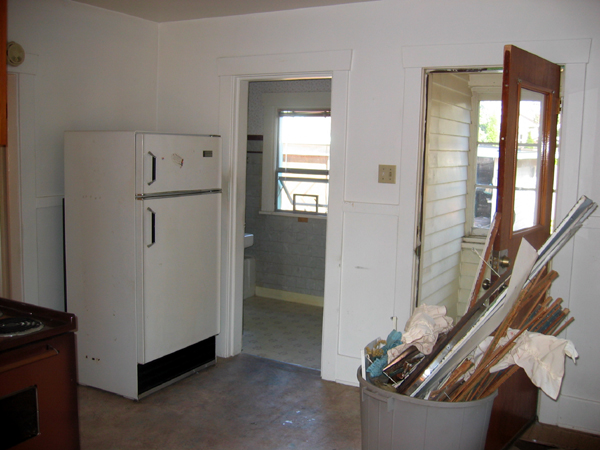




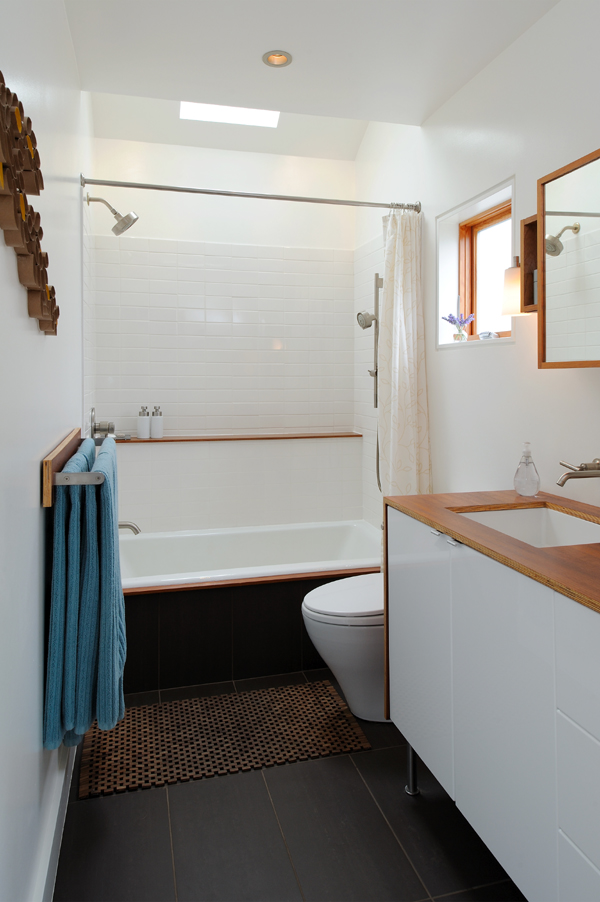


Wow, thanks for posting this. I had no idea your work was controversial and am a little outraged at some of the comments left in reaction to your kitchen and bathroom redos. Kudos to you for keeping your calm. I love what you’ve done and think it’s incredibly well considered and respectful.
Cheers to you for defending your decisions and for creating a beautiful home that’s now better in countless ways because of your thoughtful dedication.
Well said. I second the kudos for keeping calm. I find myself rarely reading the comments on certain blogs because the negative comments tend to be mean-spirited and unnecessarily critical.
Thank you so much for sharing this. We are undertaking a renovation of a period home (which had some non-faithful additions over the years) and we’re already hearing people’s opinions 🙂 (no, we can’t save the pink bathroom even if we wanted to!) For what it’s worth, I think you guys have done a beautiful job and I am glad you are not “preservation purists” – because then we never would have been able to see it!
there will always be those who have something negative to say. I LOVE your home. I am always inspired by your blog, your style, dedication and hard work. You really don’t owe an explanation to anyone, the house speaks for itself. Some people are just not listening.
Thank you for this post, wonderful as usual 🙂
Honestly, I think you two have done an amazing job – like you pointed out several times in this post, sometimes sustainability and maintenance are a behind the scenes aspect that many folks either don’t consider or understand. Regardless of the age of a home, it is up to the owners and owners alone to choose what changes and upgrades will come to the property.
You two have breathed new life into a tired old home, making it truly unique and functional.
“You really don’t owe an explanation to anyone, the house speaks for itself. Some people are just not listening.” <– Amen to that! I grew up in a 100-year old home filled with antiques, and I'm also a huge mid-century buff, but I can attest to the fact that old does not necessarily equal preservation-worthy. There's historic preservation, and then there's being a slave to impractical "original features" in your own home. Homes are for living; they're not museums. You guys have done an AMAZING job.
I came to your blog after seeing yiur home on the Design Sponge post. i also live in Ballard in Seattle and would love to buy a home here on a modest budget (though we can’t commit to as much work as you’ve done). I just wanted to say how inspiring your blog and your renovation are. Seeing your home gives me hope that we can find and create the kind of home we’d love without having to leave Ballard. Everyone’s home choices are so individual and everyone has a right to design and live in the kind of home that works for them and I think you’ve done it beautifully. I also appreciate your complete openess with your process, sources, etc. Thank you for your willingness to share your home with the world, even if that brings the inevitable comments from the crowd that can never be pleased!
I love this post! I’m a renter who dreams of being able to do something like this one day (although in Boston it’s more likely to be condo in a triple-decker or converted Victorian), and your house is probably the closest to what I want in size/function/design than anything I’ve ever come across. Hopefully someday I’ll be remembering this as I’m going through the same process myself!
I rennovated an equally decrepit old house 20 years ago and am working on my second wreck now. My experience has made me a much less sentimental person. Now I say out with the old unless it’s special or reusable. There’s no way to live responsibly, sustainably, or enjoyably in an early 20th century space unless it’s designed for modern needs. There are plenty of houses that are trying to look like they’ve spent the last 75 years in mothballs, there’s not enough modernism. You guys have done a great job.
Here here!! We bought a 70+ year old Cape because it was what we could afford. There are things worth keeping and a lot of things that aren’t. Our kitchen people could accept (prime 1950s example) but the flack for our 1950s blue bathroom!
It is falling apart! I’d love to salvage it but replacing cracked tiles is more work than it’s worth, the toilet used 3k gallons of water every 3 months and the mold for the toilet/sink is just nasty due to poor ventilation. Very hard to keep clean. It photographs beautifully.
Most of the people who comment must never have purchased an older fixer or even lived in one. I’ve always loved this blog and what you have done to your home. All the DIY information is amazing. Your house is perfect for these renovations.
This is a really nice summary of what issues you had with your home that needed to be addressed no matter what your design philosophy, and I think it’s great to think of them as opportunities to solve the issues of functionality as well. I love houses from the 1910’s and 1930’s, but not all buildings from those eras are worthy of preservation, and not every building is in a state to be preserved. At the time you bought your house, she looked a bit like an aging housewife wearing a mumu. I think that your point about the state of the neighborhood and her likely fate is also a good one. I have lived in neighborhoods like that, and I think that people who really only have experience with larger period homes may not understand the reality of these early working-class homes. Honestly, I imagine that these people who objected to your use of modern architecture are more the sort of people who care about architectural moldings and window styles than about period program, flow and function. I’ve seen a lot of homes changed to be open-concept with crown moulding and traditional furniture, with no objection to the period-inappropriateness of the renovation. Personally, I think your work is excellent and extremely sensitive to the home as a piece of architecture, considering the flow and the light, not just the surface detailing. I also love your attention to the little things and to creating elegant details, in the sense that you would use the word “detail” when referring to architectural drawings. Know that the quality of your work as architects shines through, and it keeps many of us coming back to see what’s next.
As someone said on Design*Sponge, I would like to see the homes of those who comment that they prefer the “before.” I live in a 1926 apartment that has some wonderful period details, but you have to look pretty hard considering it’s also a freakin’ dungeon with little natural light. Then there’s the persistent breeze in my bedroom from the windows that, while filled with lovely old glass, serve as only a mild buffer to the outdoors. Your home is positively inspiring.
Your work speaks for itself, but you do a wonderful job speaking/writing as well. Unfortunately, sharing your work with the world gives some anonymous folks the desire to tear it down (figuratively, not literally!). Thank you for your thoughtful response.
Great post! I was so excited to see that the Before & After made it on D*S. 🙂
If only everyone was as thoughtful as you in home improvement and remodeling! I too own a very old home and it’s a constant struggle to balance upgrades with being true to the era of the home.
I grew up in California and witnessed all the Eichlers torn down to throw up faux-Greco McMansions. I applaud you for keeping your smaller footprint and a house exterior that fits in with the other houses in the neighborhood. Your house is so beautiful.
Period program flow. Bingo.
I’ve lived in remodeled and unremodeled homes of approximately the same vintage. The unremodeled homes were a disaster in terms of usability, safety, energy efficiency and maintenance. The remodeled homes patched some of the safety and energy concerns but not the period program flow. Life has changed a wee bit in the past 80+ years. In those spaces, I often wished that I could see for a moment how people had lived in these homes around the time of their construction. Were they longing for a house that evoked the state-of-the-art of the 1850’s?
Your work on your house is beautiful and inspiring. That house is lucky to have such care and love put into it. Keep it up!
Well put and said. We’ve run into many of the same problems at our house (including IDENTICAL bathroom “tile”), and been faced with some of the same decisions. We haven’t made as many changes just due to time and budget implications, but I think you are totally justified in where you are heading. Plus, we’ve seen one of those mcmansions go up across the street from us and its worse than anything.
Thanks Martha, we really appreciate it. And good luck with your house-hunting in Ballard, I really think this neighborhood just keeps getting better and better!
Egads, you took the words right out of my keyboard. I was literally going to type “Houses are for living in – they’re NOT MUSEUMS!”
Finding vintage tiles and plumbing fixtures and doorknobs is all fine and good if you live in a larger city, but what if you don’t? What if it takes you 3 years to find matches for your busted “vintage” bathroom taps? Are you supposed to go without taps? That’s no way to live!
Some people need to get their elitist design attitudes adjusted if they think that *just* because something is old that it is a) functional, b) authentic, c) well-built and d) beautiful. Sometimes old just means broken-down and wrong. My own home 60-year-old is a prime example.
“Were they longing for a house that evoked the state-of-the-art of the 1850′s?”
EXACTLY!
Also, you’re so right – life has completely changed in the past 80 years. Why do people expect houses to stay the same?
Design is not window moldings – that’s called decoration. *Design* is function. My professional motto: If it don’t function, it ain’t designed right.
Great post. Those who wish to preserve homes should buy them and do so or help raise money for others to do the same.
“preservation” turns into fascist dialectic in a flick of an eye.
http://www.themodernword.com/eco/eco_blackshirt.html
i think you have struck the exact right point, to renovate lovingly and personally, within the bounds of a young couple’s budget, its neighborhood, its footprint, and its homeliness, a well-designed small space another young family will sustainably be able to afford when/if you all move on. plus, the staving off of the macmansion on too small a plot? priceless.
i think also that learning how to weld or parge is about a million times better than more bs in the academy.
go, you. somebody on the internet is wrong? pay no attention.
Thanks for the inside look at your house renovations and for bringing up this discussion. I’ve experienced the nastiness that can be found in the comments section of Apartment Therapy so I know how vile some of those people can be firsthand, which is unfortunate. Also unfortunate is when people don’t know the situation behind your choices but have somehow decided they should know better for you and your home. I would have loved to found a home that warranted restoration but the truth is a lot of people got ahold of this place far before us and we needed to focus on righting some very major wrongs and that included replacing leaky aluminum windows. Would you believe that someone had the gall to tell me that it was irresponsible of me not to have gone out and found salvage windows not original to my house and restore those instead? You know, with my copious time and knowledge of windows? Sometimes you can’t win for trying. But I digress. Your home is beautiful and modern and lovely. Congrats on a great remodel.
i think folks are more likely to speak up about what they don’t like rather than praising what they do like. half the comments i read on at and design sponge are cranky comments. who needs em?! they don’t understand house love nor individuality and probably don’t have a cool dog either.
You’ve done a great renovation and have a beatiful house. I really enjoy reading your posts. Thanks so much.
Your home is amazing. I love your taste. Very Scandinavian modern. You guys have come up with very creative solutions that are aesthetically and functionally sound. Yes there are times to keep it original, but I completely agree with the direction you went. The house was not worth restoring only to live with the compromises that come with a very old house. It doesn’t strike me as being originally architecturally significant. However, it does now!
I’ve been following your blog for just a short time and, even as a long time primitive antique dealer, I just LOVE what you have done!!! You have SAVED history, my dears. And added the next chapter to this little house’s life.
BRAVO!
PS If your home was built in 1910–the kitchen that you “ripped the charm” out of was a 1930’s modern update.
Just imagine, in 70 years, when your current kitchen is modernized….people will complain about the history being lost…………….
I think you’re totally right…afterall, under the plaster walls we found wallpaper so we know that the plaster was an “upgrade” at somepoint. And yes, it *is* crazy to think that this whole conversation might occur again in 70 years!
Aww, thanks!
Ha! Bailey agrees with this.
I know, I think it is hard to tell the whole backstory in the snippets that get posted on the internet and people often make assumptions based on their own experiences or ideas. I guess one solution is for people to be as open-minded as possible and proactive about educating themselves on the various issues and solutions when it comes to old homes. Ok, that’s probably wishful thinking but that’s what I try to do (b/c I’ve definitely made assumptions about other people’s homes even if I didn’t leave a comment!). I think most homeowners are truly trying to do the right thing with the time and resources that they have.
Such a gorgeous remodel and story. Hard to believe anyone would take issue with the transformation and hard work you’ve put in. I’m seriously in awe!
We’ve just been through a similar dilemma with our home, a 1935 Mediteranean tract home. We bought the home as a starter with plans to sell after 5 years. It was never really our style but we loved the neighborhood, and modernist homes are nearly impossible to come by in older cities. Eleven years later here we are, and due to economic forces, we’re staying here a while. We kept the dark mahogany trim for resale and preservation all these years, and tried to make our modern esthetic work with it. Just recently we finally painted over it and I love our new room because of it. As much as I have an appreciation for older homes, at a certain point you have to give yourself permission to make it your own.
For me, I see the difference between an architect and a builder – or the difference between an architect and your average homeowner-turned-renovator – underlying this discussion.
I love reading your blog and seeing your projects specifically BECAUSE you are architects and you think more fully and carefully and considerately than most bloggers/renovators on this topic. As beautiful as I find your home, it is your particular (architect’s) perspective that makes your voice, blog, and renovation valuable.
I’m glad you are here, in the blogosphere. And I hope to see more architects, because I think communicating WHAT exactly we do is really important. And, yes, it’s a lot more than eye candy.
You stayed true to your vision, and 100 years from now someone will probably be complaining about how someone else wrecked your vision. *shakes my head*
Your house is a gem, due entirely to the meticulous efforts and impeccable craftsmanship you and your husband have put into it. Anyone who has read any of your blog entries (really, even just one) would know that you carefully think through everything you do to your house, and then work hard as hell to execute your choice to a beautiful standard. Look at the care you took with your cabinet and drawer pulls! The fact is, a lot of older homes were put up quickly and cheaply and are not artisanal masterpieces of old-world craft. I doubt their builders expected them to be around 100 years later.
We bought a 1920s home that we thought was in pretty good shape. But every little thing we’ve done to it has revealed a host of underlying problems. You can read about it magazines or blogs, but until you own an older home, it’s hard to really understand that there are no simple fixes. You cannot preserve a 90-year-old bathroom that is leaking into the living room below because you love old tiles and the razor-thin grout lines. There is so much to love about older homes, but living in them as they were built is a PBS reality series (“1900 House”), not a pragmatic, or responsible, choice.
I think your remodel has been very well thought out. I’m really glad you have shared so much of it.
I do not have enough time to read all the comments that were left here so hopefully I am not repeating something however, when I look at your home I see two passionate people who worked hard to take something with good bones and make it work for them. When I look at the before and after of the exterior I can see exactly how you kept the integrity and lines of the home but again gave it the modern facelift it needed.
I had a space of mine featured on Apartment Therapy and actually had some bickering in the comments defending what I had done. At first it bummed me out then I realized that there were more compliments than negative feedback and just focused on the positive. The haters will always be out there no matter how wonderful your work is…and your work is pretty wonderful.
well played.
As several people have mentioned here, it is the thoughtfulness of your remodel that really sets your home, and your blog, apart (that and all the physical labor!!). I recently partially renovated a 1920’s home and agonized over any decision that touched something “original”, even though owners over the decades had added their own strange things. After I reminded myself that the original builders were practical as well as craftsmen, it was easier to keep the truly evocative, well-made things but revisit the ridiculously undersized kitchen storage areas. I’ve enjoyed reading about your remodel decision-making process over the past several months because it helped me feel like there were other folks out there struggling with some of the same issues. And your results are really something to be proud of!
I have been reading your blog for only a few months and really get a great deal of inspiration and enjoyment from it (along with killer cute pet photos). Thanks for sharing your home and hard work with the world.
I have little to add to this conversation, except to join the chorus of your supporters. I’ve largely stopped reading the sites notorious for snarky, critical comments. Not only are the comments offensive, but those sites (Apartment Therapy, in particular) expose us to an obnoxious level of advertising.
I’ve been reading your blog for a while (another Seattleite, we emailed once) and I wonder if the commenters realize there are SCORES of small bungalows in Seattle, which range from incredibly well built and charming to quickly and cheaply built and uncomfortable. I have been looking for a house for quite some time, mostly in the Queen Anne area. Personally, I hate the Craftsman aesthetic. I understand why other people like it but it is totally not me. We just put an offer in on a lovely modern home (wish us luck!) but definitely considered several that would have been heavily and not period-appropriate renovated or torn down and rebuilt. Not talking McMansions, but modern clean lines, etc.
“old does not necessarily equal preservation-worthy.” Oh, so true. I’m thinking of you, Antique Malls around the country selling someone’s discarded rusty machine-made mass-produced trash as vintage antiques!
i knew he would!
Thanks Ann for the thoughtful comment, I definitely agree. I wish there were more architect-renovation blogs too, I know so many people doing equally (if not more!) awesome things to their homes, but they’re just not blogging about it. =)
I think you have a good point, there are a ton of pre-1930’s homes here and they range considerable in quality. I think a lot of times people just have a knee-jerk reaction to stuff that’s old. Good luck on your house, hope you get it!
I “read” along as you were doing the remodel and I really love it. I think the pictures of the before on design sponge and apartment therapy don’t show how bad the kitchen really was. I didn’t really get what your plans were and how awkward the layout was until I you posted the floor plans. They don’t even mention the fake head clearance cabinet , who would choose to keep that.
Great post – particularly the before and afters.
Perhaps it’s because I’m not from Seattle, but frankly, I don’t think you should have to justify a damn thing about your renovation. Did you buy a museum? No. You bought a dumpy fixer-upper and transformed it into something spectacular. If people aren’t a fan of your taste in fitout, that’s their prerogative. But to criticize it for not keeping the original layout….madness. it’s also yours to do whatever you like with whatever you own. Personally I think you’ve done a brilliant job on a budget. Well done.
Right on Mikey, I totallly agree but I guess when you put yourself out there you’re kinda asking for people opinions? Maybe? I guess certain people will always have an opinion. =)
If I were your neighbors, even if I had restored home true to the architecture, I would be thrilled to have your home on the block. Great design speaks for itself, whether you are restoring or re-imagining the architecture – and your home is really is great design.
It is beautiful, you love it and it reflects your style. That is really all that should matter.
Thanks for sharing it with us. Every week I am inspired by what you do.
have loved your house ever since i found it several months ago. most people would have either kept it in piss poor condition, or razed it. your path has and continues to inspire, keep up the beautiful work!
I’m a preservationist. I live in a historic neighborhood, have brown antiques, and go insane when I see 18th-century hand-made furniture painted glossy white on blogs.
But I think your renovation is great.
My rule of thumb about renovation is this: If I saw stuff from the “Before” in an archi-salvage store, would it make my heart skip a beat? Or would it look like junk? You weren’t exactly ripping out hand-carved woodwork there.
And as for being green… you’ve given new life to a house that, as you note, probably would have been torn down for a new building. Good job!
Common people, I can’t believe you took down that beautiful, blue, faux marble tile in the bathroom and didn’t restore that cracking plaster! That was so much better than the clean, boring, shiny white tile you have now! Seriously, your place is gorgeous and I have no idea what all the naysayers are talking about. As a remodeler myself, I believe these people clearly haven’t lived with:
1. old kitchen cabinets that don’t close, have so many layers of paint, and don’t glide on rollers so that every time you open a drawer, you risk losing your feet.
2. non insulated walls which will make the family huddle together into the middle rooms of the house during the winter months just to stay warm at night.
3. single pane aluminum or steel windows that don’t shut all the way and might as well just be screens with the amount of air that actually passes through them
4. original wood floors that creak and wake up the baby, or worse, are so thin that you get splinters.
5. plaster walls that crumble if you try to install any kind of artwork, crack if you want to install additional ceiling lights, and will only stay patched and smooth for about 4 weeks.
my husband and i still hold up our fists at our old plaster walls and ceilings and wonder why we didn’t just take it all down 8 years ago when we first moved in! argh!
Some things are worth preserving and restoring, other things really need to be brought into the new millennium!
Come on people, I can’t believe you took down that beautiful, blue, faux marble tile in the bathroom and didn’t restore that cracking plaster! That was so much better than the clean, boring, shiny white tile you have now! Seriously, your place is gorgeous and I have no idea what all the naysayers are talking about. As a remodeler myself, I believe these people clearly haven’t lived with:
1. old kitchen cabinets that don’t close, have so many layers of paint, and don’t glide on rollers so that every time you open a drawer, you risk losing your feet.
2. non insulated walls which will make the family huddle together into the middle rooms of the house during the winter months just to stay warm at night.
3. single pane aluminum or steel windows that don’t shut all the way and might as well just be screens with the amount of air that actually passes through them
4. original wood floors that creak and wake up the baby, or worse, are so thin that you get splinters.
5. plaster walls that crumble if you try to install any kind of artwork, crack if you want to install additional ceiling lights, and will only stay patched and smooth for about 4 weeks.
my husband and i still hold up our fists at our old plaster walls and ceilings and wonder why we didn’t just take it all down 8 years ago when we first moved in! argh!
Some things are worth preserving and restoring, other things really need to be brought into the new millennium!
Your reno is amazing. I love the kitchen so much, just like the loft staircase and your dog. I love seeing the floor plan changes and the DIY work. I think the minimalist home decor vibe is just the house was needed. Thanks for sharing pics, I just pinned some of them. Very inspiring!
We’ve renovated at least 5 houses in our 10 years of marriage. We too, like the older homes. Sometimes there are things that you can save from the house that are original, sometimes you can’t. But in the end, it’s YOUR house-not someone else’s. We love what we have done to update for functionality’s sake in our current 1920’s home, but we have had some people not as in love with the changes as we are. For examples, we poured concrete countertops and bought plain, white Ikea cabinets that we paired with barn flooring recycled from my hubby’s century farm. It works for us and most love it-but we’ve had the naysayers, too. I feel your pain!
You can see some of the finished results from remodeling our current home here (along with most of our other remodels) on my site. But here’s a direct link to our current home:
http://www.potholesandpantyhose.com/2010/05/my-home-tour/
Hope you have a great remodeling day today!
Thanks Rebekah, I think your kitchen looks great! Wow…5 houses in 10 years…that’s a lot of work!! I don’t think we could do another one (to the extent we’ve remodeled our current house at least!).
I’m an architecture conservator and the only thing that irritates me about renovations (besides the people who think that means the same thing as a “restoration”) is the use of inappropriate, shoddy materials. People have been expanding their homes for as long as there have been walls and roofs and they do it with what they have to hand. But the difference between good and bad comes down to forethought. When we have the opportunity to use well-made, well-planned materials, then I’m all for it. Your home is a beautiful example of that and it’s a shame that so many people want to give my industry a bad name by making it out to be in favor of mothballing homes instead of making them truly livable.
Well said, thanks Jen.
I adore your house. I appreciate the preservationists who caution against thoughtless destruction of great old elements, but all I can say is… have they seen your place??? It’s stunning, thoughtful, a work of art and simplicity. If the old elements were beautiful and functional, you did preserve them. If they were cheap and broken down, then do what you gotta do.
Currently undergoing a renovation, in our first year, also under a very tight budget but with much less personal expertise in construction. Thank you for posting your experience and reminding me that it won’t (and can’t) happen all at once and that it should be a process of creativity and joy. The result of your work is truly inspired.